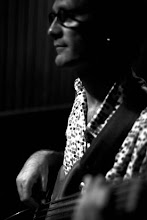I haven't updated this build lately. But the build has gone forward and it's almost over. The ETS bridge has arrived and so have the p-ups and the Tusq nuts. Everything else is custom made by me anyway, so that's never been a problem - other than deciding how to exactly custom make them, that is.
The picture below shows how the bridge placement was fixed and routed. It's a 34" scale and as you know, the bridge has to fall right at the edge of the body - to keep the bass as compact as the design allows. t the same time, the body must be routed under the tuners to make tuning possible.

The ETS is very different form the ABM individual strings bridge of the previous build. It works best when at an angle with the saddles, so the body needs to be shaped accordingly.

The neck pocket has been routed and I have made book-matched veneers to cover the extended neck beyond the 22nd fret. It had to be book-matched to er...match the top which in that area is in fact book matched. Did I say book-matched?

This build was crying out loud for block inlays. It took a couple of days to complete but it was worth it. Matching Camphor Burl blocks really add to the overall look, spicing up the subdued style of the Flamed maple f/board.


The neck has been shaped. It is slimmer than the first one and narrower at the nut. In this picture the head stock has not been shaped yet. It will be, in a style much likely the previous Über0-Jay.

The tapered Padauk laminate works really well with the Birdseye Maple. It will surely become a constand element of my next buids.

The headstock has been shaped and drilled for strings anchors and ferrules. The nut slot has been carved and the nut sanded almost to measure. The final fit will be done with strings mounted.

The body ha been routed for p-ups and the chambers/cavity are all interconnected. This makes wiring a breeze. All cavities and chambers were planned a mere 3 millimeters from each other therefore it took me just a few seconds with a good chisel and a file to connect them. It really worked well.

This is the bass assembled. Very little is missing now - strap locks, pots and jack holes - before lacquering. I'm probably going to stain the body grain black. We'll see that. two weeks worth of work is all this bass needs. But I had to leave for 5 weeks and so had to put this beauty on hold.

The amazing thing is, without hardware and electronics - as is - this build weights a mere 1.7 kg. I don't believe hardware and electronics will add more than 1 kg - if, at all. The p-ups are unusually light, it's passive, knobs are made of plated Aluminum, nut is a feather light Tusq and string anchor.ferrules weight not more than 50 g. This bass is gonna need an anchor to stay grounded ;)
Thank for reading
O(=<













































